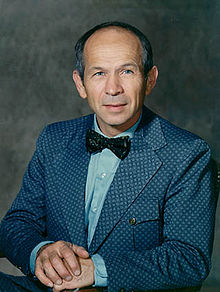- Maxime Faget
-
Maxime Faget 
Maxime FagetBorn August 26, 1921
British HondurasDied October 9, 2004 (aged 83)
Houston, TexasNationality American Other names Max Faget Occupation engineer Known for designer of the Mercury capsule Maxime "Max" A. Faget (pronounced FAhzay) (August 26, 1921 – October 9, 2004) was the designer of the Mercury capsule, and contributed to the later Gemini and Apollo spacecraft as well as the Space Shuttle.
Contents
Life
Maxime Faget was the son of Guy Henry Faget, and grandson of Jean Charles Faget. Born in Stann Creek, British Honduras, Faget attended community college in San Francisco, California, and he received a Bachelor of Science degree in Mechanical Engineering from Louisiana State University in 1943. After three years as a submariner in the U.S. Navy, he joined the Langley Research Center in Hampton, Virginia as a research scientist. While working for NACA at Langley, Faget worked on the design of the X-15 hypersonic spacecraft.[1]
In 1958, Faget became one of the 35 engineers who formed the Space Task Group, creating the Mercury spacecraft. Faget based his designs on the aerodynamic work of Harvey Allen from the mid-1950s, and was instrumental in selecting the blunt-body shape that won the Mercury competition over numerous contenders. Faget also led the development of the escape tower system used on Mercury, which was used in various forms on almost all following manned spacecraft. Faget also worked on the Gemini and Apollo vehicles, which shared many design points with the Mercury.[2]
Faget filed a patent for a space shuttle vehicle design in 1972. His design, which he named "DC-3" in homage to the famed Douglas DC-3 airliner, was a small two-stage fully reusable shuttle with a payload capacity around 15,000 pounds (6,800 kg). DC-3 was officially studied by North American Aviation and shown in the press as a baseline contender for the Space Transportation System (STS). North American also studied a version of the same basic system with a much larger 50,000 pounds (23,000 kg) payload. However, the DC-3's nose-high re-entry profile was controversial, and eventually doomed it when the US Air Force joined the Shuttle program and demanded cross-range performance that the DC-3 simply couldn't meet. In the end, its most lasting contribution was to clearly identify the trade-offs inherent in any reusable design.[3]
He continued to work for NASA until his retirement in 1981, shortly after the second Space Shuttle flight (STS-2). After his retirement, Faget was among the founders of Space Industries Inc., established in 1982. One of the projects of the company was the Wake Shield Facility, a device to create near-perfect vacuum in space. The WSF flew three times with a Space Shuttle in 1994–96 (STS-60, STS-69, STS-80).
Faget is a member of the National Space Hall of Fame and the National Inventors Hall of Fame, and is a recipient of the NASA Medal for Outstanding Leadership.
Faget died of bladder cancer on October 9, 2004, aged 83.
MAX-1 Spacecraft
The private spaceflight organization Copenhagen Suborbitals has named their next piloted spacecraft after Faget, the MAX-1.
References
- ^ Maxime Faget, inventor profile, National Inventors Hall of Fame, 2002
- ^ Oberg, James. "Max Faget: Master Builder". http://www.astronautix.com/articles/maxilder.htm. Retrieved 2007-01-12.
- ^ Marcus Lindroos, MSC/North American Concept-A "DC-3"
Patents
Max Faget was a co-inventor on five United States patents issued to Space Industries, Inc. between 1988 and 1992. The patents, which are listed below, can be found at the USPTO's public web site. PAT. NO. Title
- 5,104,070 Structural latch for vehicle coupling mechanisms
- 4,903,919 Apparatus and method for docking spacecraft
- 4,834,325 Modular spacecraft system
- 4,747,567 Spacecraft with articulated solar array
- 4,728,061 Spacecraft operable in two alternative flight modes
External links
Categories:- 1921 births
- 2004 deaths
- Deaths from bladder cancer
- Louisiana State University alumni
- Mercury program
- Mechanical engineers
- National Inventors Hall of Fame inductees
- NASA personnel
- United States Navy officers
Wikimedia Foundation. 2010.
